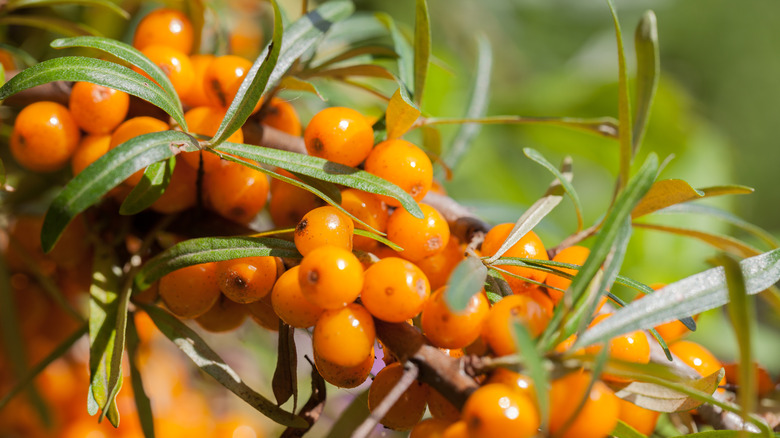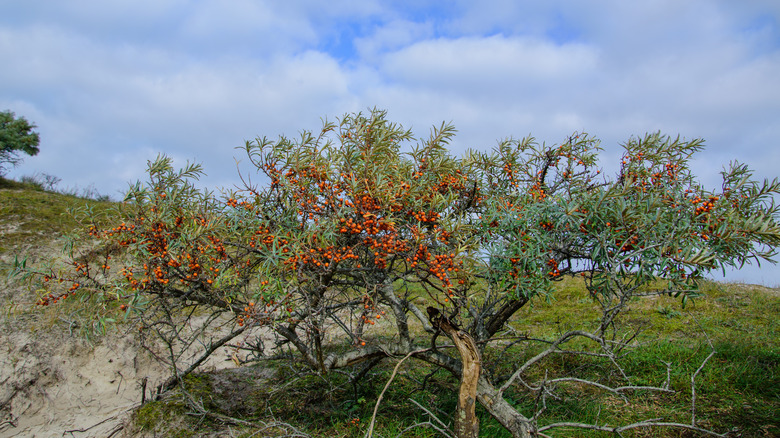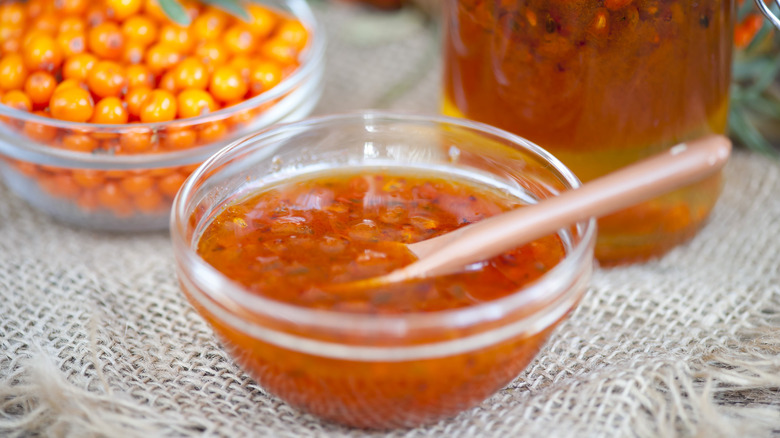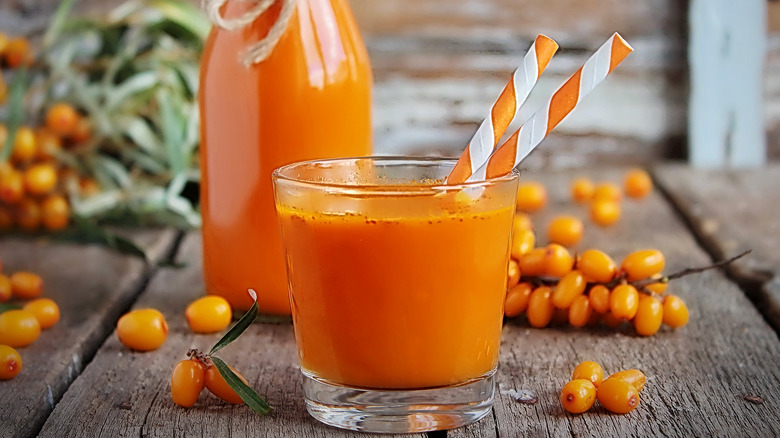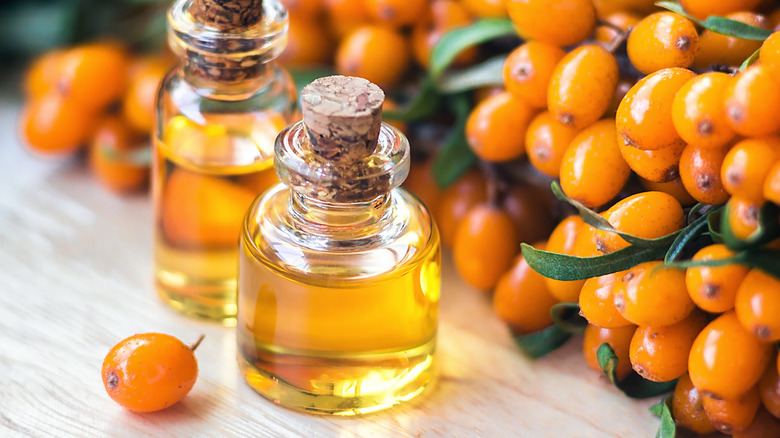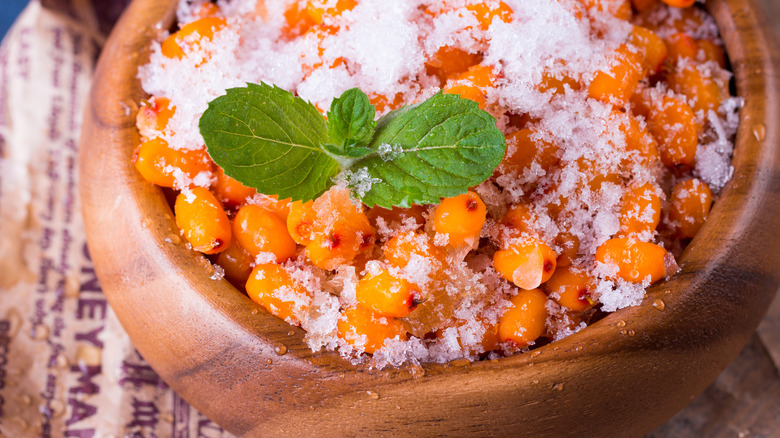Seaberry Is The Unique Fruit With A Bright Citrus Flavor
Seaberry, also known as sea buckthorn, is a small fruit with big flavor and even bigger benefits. Known to the scientific community as Hippophae rhamnoides, hippophae translates into "shiny horse" in Latin — apparently, Alexander the Great fed seaberries to his horses to maintain their health and shiny coat. And legend has it Ghengis Khan left his injured horses after battle beside a seaberry shrub to die, but the following morning he found the horses recovered and back to their fighting selves. The Chinese use seaberry for ulcers, eye, and heart health, and its oil is gaining popularity in the cosmetic industry. You may have come across them used in floral arrangements as well.
Seaberry is seeing a surge in popularity for its health benefits, skin care properties, and culinary applications, but given the fruit's storied history, we may have dropped the ball on discovering the diverse blessings of the berry. What do you need to know about this tiny fruit?
What is a seaberry?
A seaberry is about the size of a cranberry. These berries grow in varying shades of bright orange and have thin skin and a translucent, dark yellow or bright orange interior with hard, small seeds. Seaberries do not grow in the ocean, but they can be found near the sea. They are most commonly found in Russia, China, Mongolia, and Northern Europe as well as along the coastline of the United Kingdom. Seaberries grow on shrubs that range from 6 to 18 feet tall and begin to grow in clusters on the shrub two to three years after it is planted. The berries ripen in late summer, and an average of 30 to 50 pounds of berries are harvested from each shrub annually. Seaberries have silver-green leaves and thorns, hence their alternate moniker of sea buckthorn.
The seaberry shrub is able to withstand both cold and hot temperatures. They are a hardy crop that can handle tough conditions and are resistant to pests. They are known as the Siberian Pineapple in Russia due to their ruggedness. Written records of seaberries go as far back as 300 B.C. in Greek texts.
What does seaberry taste like?
Seaberries have a citrus-like flavor. They are tangy and tart, and the taste is described as being akin to mango, passion fruit, and apricot. Some liken them to pineapple and orange. However, because they grow in colder climates, the natural sugars don't ripen as much as their tropical, sunbathed counterparts. The berries are more sour, astringent, and acidulous than they are sweet.
While some people may eat the berries raw, they are generally considered unpalatable on their own due to their tartness. To counterbalance the sourness, seaberries are often prepared with some kind of sweetening agent. They are made into a jam and are popular for juicing. Seaberry can even be turned into a bright orange wine, and has inspired some unique spirits. Candy, ice cream, sorbet, and baked goods are other common applications of seaberries. They can also be made into syrups and teas or incorporated into salad dressings for an added zing. Seaberries are also often made into a sauce and served with roasted meats or paired with cheese.
Seaberry is a superfruit
According to the Canadian Academy of Sports Nutrition, 1 cup of seaberries has 158 calories, 22 grams of carbohydrates, 3 grams of fiber, 2 grams of protein, and 7 grams of fat. Those 7 grams of fat are composed of omega-3, 6, 7, and 9 essential fatty acids which benefit cardiovascular health and combat inflammation, per WebMD. Omega-7 is rarely found in plant sources, making seaberries an excellent option to get the unsaturated fatty acid which is known to help lower cholesterol. Seaberries are rich in vitamins A, K, and B vitamins, and are also a great source of vitamin C, containing 15 times the amount found in a comparable amount of orange. Seaberries are also rich in phytonutrients, which provide antioxidants that protect our cells from damage by free radicals and may reduce our risk of disease. They are also high in potassium, magnesium, and copper.
Therapeutic uses of seaberries
Sometimes dubbed the "Miracle Plant," "Wonder Plant," "Holy Plant," and "Gold Mine," seaberries are not just superfruits — they are known to have therapeutic and medicinal applications. Seaberry oil is often used in Ayurveda and Traditional Chinese Medicine and they were referenced in ancient medicinal Tibetan texts from the 8th century. It's said that seaberries were used by Russian cosmonauts during the space race to counteract radiation, and the Chinese Olympic team used them in their drinks during the Olympic games.
A review published in Frontiers in Pharmacology in 2018 found that, although further research is needed, seaberries may have practical applications in the prevention and treatment of cancer. They were shown to boost the immune system as well as restore kidney and liver function and appetite after chemotherapy treatment.
Seaberries are also referred to as the Beauty Berry in Europe and Asia and for good reason. The oil extracted from the fruit and seeds offers a myriad of benefits for the skin. The unique fatty acid composition of the plant helps with dry, flaky, and aging skin, and the omega-6 and omega-7 present have regenerative properties. Seaberry oil easily penetrates the skin and helps with circulation and detoxification.
Where to find seaberries
If you're looking to include some of this magical little berry into your diet, you may be hard-pressed to find it fresh anywhere, unless you reside in Finland, Sweden, or Canada. As it's not that appetizing on its own, seaberry is often found in other slightly processed fashions. The closest you'll probably come to raw seaberries is checking the freezer aisle for a bag of them frozen (the berries are slightly sweeter once frozen). The next likely option would be dried seaberries, which add a tangy citrus taste and crunch to salads, oatmeal, and baked goods, or enjoyed on their own as a snack. You may also come across bottled seaberry juice, preserves, or tea.
Powdered supplements made from dried seaberries are becoming increasingly popular as are supplement capsules. Cold-pressed seaberry oil is pretty widely available and can be used in cooking, such as in a salad dressing or smoothies, or used as a facial or body moisturizer. Keep in mind many seaberry products may be labeled as sea buckthorn, but are ultimately the same thing.
